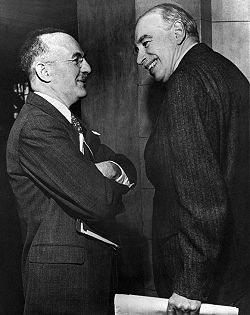Design
Free trade relied on the free convertibility of currencies. Negotiators at the Bretton Woods conference, fresh from what they perceived as a disastrous experience with floating rates in the 1930s, concluded that major monetary fluctuations could stall the free flow of trade.
 The new economic system required an accepted vehicle for investment, trade, and payments. Unlike national economies, however, the international economy lacks a central government that can issue currency and manage its use. In the past this problem had been solved through the gold standard, but the architects of Bretton Woods did not consider this option feasible for the postwar political economy. Instead, they set up a system of fixed exchange rates managed by a series of newly created international institutions using the U.S. dollar (which was a gold standard currency for central banks) as a reserve currency.
The new economic system required an accepted vehicle for investment, trade, and payments. Unlike national economies, however, the international economy lacks a central government that can issue currency and manage its use. In the past this problem had been solved through the gold standard, but the architects of Bretton Woods did not consider this option feasible for the postwar political economy. Instead, they set up a system of fixed exchange rates managed by a series of newly created international institutions using the U.S. dollar (which was a gold standard currency for central banks) as a reserve currency.